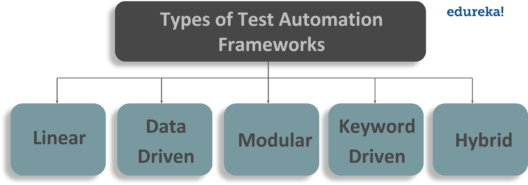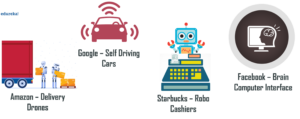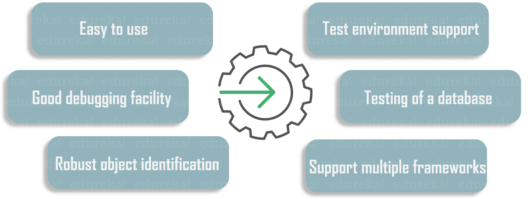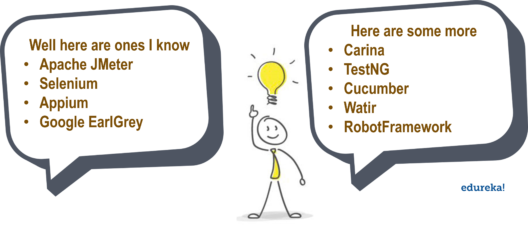Selenium Course
- 64k Enrolled Learners
- Weekend/Weekday
- Live Class
Testing is crucial to the success of any software product. The prime objective of software testing is to get a high-quality output while reducing the cost and the time required to complete the project. But testing to find defects or bugs manually is time-consuming, expensive, often repetitive, and subject to human error. This is where automation comes into the picture. The Automation Testing Course is the perfect guide for learning how to be a Test Automation Engineer.
Test Automation or Automation Testing uses the assistance of tools, scripts, and software to perform test cases by repeating pre-defined actions. Automating software testing will give companies a competitive edge in the market.
With the adoption of automation becoming increasingly widespread, software testers with manual testing skills alone won’t be able to make it in today’s job market. If you are preparing for an Automation Testing job interview, you must be aware of the most frequently asked questions in the this field. With that in mind, in this article, I will discuss the top Automation Testing interview questions and answers. For your better understanding, I have divided the QA automation interview questions into the following sections:
This section of automation testing interview questions for freshers will cover all the basic questions you need to know as a beginner.

Different types of test automation are unit tests, GUI tests, and functional tests.
Functional tests are also done at the testing level to simulate the functional scenarios to test the application with provided input and for expected output.
Related Learning: Types of Automation Testing
An automated test script is a short program written in a programming language to perform a set of instructions on an application. This is done to verify if the application is as per the requirements or not. When you run the script, it gives the test results as pass or fails based on whether the application is working as per the expectations.
Certain good practices that you should follow when writing test cases are:
A test automation framework is a set of universal guidelines and rules used to produce beneficial results for test automation activity. The automation framework combines function libraries, test data sources, object details, and other reusable modules and methods. The automation framework makes testing consistent. Some of the guidelines are as follows:
Using an automation framework avails a lot of benefits like:

Linear Scripting Framework: It is a basic level test automation framework in the form of ‘Record and Playback’ but in a linear fashion. This type of framework is mostly used to test small-sized applications.
Data-Driven Framework: It creates test automation scripts by passing different test data sets. The test data, which includes input, expected output, and a result field, are stored in CSV files, excel files, text files, XML files, etc.
Modular Testing Framework: Here, the testers divide the application into multiple small modules and create test scripts individually. These individual test scripts are combined to make larger test scripts using a master script to achieve the required scenarios.
Keyword Driven Framework: In this framework, testers use a table format to define keywords or action words for each method. Based on the keywords specified in the excel sheet test, scripting is done, and tests are executed.
Hybrid Testing Framework: As the name suggests, this framework is the combination of two or more frameworks mentioned above. It attempts to leverage the strengths and benefits of other frameworks based on the tester’s requirements.

Q9. What are the factors that determine the effectiveness of Automation Testing?
The factors that determine the success are:
| Manual Testing | Automation Testing |
| In manual testing, the accuracy and reliability of test cases are low, as manual tests are more prone to human error. | On the other hand, automated testing is more reliable as tools and scripts are used to perform tests. |
| The time required for manual testing is high as human resources perform all the tasks. | The time required is comparatively low as software tools execute the tests |
| In manual testing, the investment cost is low, but Return of Investment(ROI) is also low. | In automation testing, investment cost and Return on Investment are both high. |
| Manual testing is preferred when the test cases are run once or twice. Also suitable for Exploratory, Usability, and Adhoc Testing. | You can use test automation for Regression Testing, Performance Testing, Load Testing, or highly repeatable functional test cases. |
| Allows for human observation to find out any glitches. Therefore manual testing helps in improving the customer experience. | As no human observation is involved, there is no guarantee of a positive customer experience. |
100% automation is not achievable. Because certain test cases cannot easily be automated, in such cases, writing automation tests will take far more effort than it would ever save. For example, checking the background color of a window or dialog box. Creating a test case for such a simple task would take double the time and effort. Manual testing is best in such cases. So, complete automation is not possible. Check out Manual Testing Course to learn more.

Well, there are a plethora of examples that I can list. Here are a few interesting ones. Amazon is testing delivery drones that pick up warehouse orders sorted by robots. Google is testing self-driving cars. While Starbucks is testing cashier-free stores dedicated to mobile ordering and payment. Facebook is testing a brain-computer interface that may one day translate thoughts into digital text.
Automation testing isn’t a replacement for manual testing. No matter how good automated tests are, you cannot automate everything. Manual tests play an important role in software development and come in handy whenever you have a case where you cannot use automation. Automated and manual testing each has its own strengths and weaknesses. Manual testing helps us understand the entire problem and more flexibly explore other angles of tests. On the other hand, automated testing helps save time in the long run by accomplishing a large number of surface-level tests in a short time.

Documentation plays a very important role in Automation testing. All the methods and procedures you employ should be documented to be repeatable. Test specifications, designs, configurations, code changes, automation plans, test cases listed for automation, bug reports, and user manuals should all be documented.
Some of the most popular automation testing tools include Selenium, Watir, Ranorex, Appium, UFT, Tosca, and SoapUI.
This section of Test Automation Interview Questions will cover topics like why automate, how to automate, and automation testing tool selection.
There are certain cases where manual testing is preferred over automation testing, like:
Ad-hoc Testing: In ad-hoc testing, there is no specific approach. It is a totally unplanned testing method where the tester’s understanding and insight is the only important factor.
Exploratory Test: This testing requires the tester’s knowledge, experience, analytical, logical skills, creativity, and intuition. So human involvement is important in exploratory testing.
It is impossible to automate all test cases, so it is important to determine which ones to be automated first. There are some top candidates like:
Success in automation testing requires careful planning and design work. The steps include:

Code-Driven Testing: Here, the focus is mainly on test case execution to determine whether the various sections of code are performing as per expectations. This testing approach is a popular method used in agile software development.
Graphical User Interface (GUI) Testing: This approach may test applications with GUIs. Testers can record user actions and analyze them any number of times. Test cases can be written in several programming languages like C#, Java, Perl, Python etc.
Test Automation Framework: Framework is a set of guidelines used to produce beneficial results of automated testing activity. It combines function libraries, test data sources, object details, and other reusable modules.
Find out our Automation Testing Training in Top Cities/Countries
| India | Other Cities/Countries |
| Bangalore | UK |
| Hyderabad | USA |
| Pune | Canada |
| Chennai | Singapore |
To decide which tools to choose, you can follow the steps listed below:

Uniformity in naming convention, commenting on the functionality whenever and wherever necessary, adequate indentation, robust error handling, and the ability to recover easily are some good practices you should follow while scripting.
The advantages of using a automation testing framework are:
Test Assertion Tool: This module will provide assert statements for testing the expected values in the application under test.
Data Setup: Each test case needs to take the user data from the database, a file, or embedded in the test script.
Build Management Tool: Tool that you can use to build a framework so that you can create test scripts.
Continuous integration tool: Continuous Integration/Continuous Delivery tools are required for integrating and deploying the changes done in the framework at each iteration.
Reporting tool: A reporting tool is required to generate a readable report after the test cases are executed. This way, you can better view the steps, results, and failures.
Logging tool: The tool in the framework helps better debug errors and bugs.

100% automation testing is impossible. Manual testing is still necessary. Tests that cannot be automated are:
This section of QA automation interview questions for experienced will cover tricky questions to check their expertise.
The advantages are:
Disadvantages include:
Automated testing can be both black or white box type of testing depending on the scenarios in which automation is performed. It is black box testing as a tester usually tests the application without knowing its low-level design or code. But sometimes, automated test scripts need access to the database details that are used in the application. Thus, it can be a type of white-box testing as well.
Some of the challenges that you come across while using frameworks are:
The aim is to simplify the testing process involving complex and huge data sets. In Data Driven Testing, the test data includes input, expected output, and a result field. These fields are listed in CSV files, excel files, text files, XML files, etc. These files are then fed to the automation tool for execution, which compares the expected and actual data. Then the obtained results are documented in the result field.
TestNG is an open-source automated testing framework, where NG refers to NextGeneration.The creator of TestNG is Cedric Beust. It is inspired by other frameworks like JUnit and NUnit. It is designed to be better than JUnit, especially while testing integrated classes.TestNG allows the developer to write more flexible and powerful tests with ease. Some of its prominent features include:
Related Article: Top Manual Testing Interview Questions
In TestNG, testing is based on Junit, but it is designed to overcome the limitations of JUnit. Some advantages of TestNG over Junit are:
Test teams responsible for product development at companies adopt Agile practices to achieve their goals. Automation testing is a fundamental part of Agile, but there are certain times when automation testing in agile is useless, like:
To get maximum ROI, keep track of the following points:
Some of the risks involved are:
Well, that’s it! We have reached the end of the Automation Testing Interview Questions and Answers Article.
I hope the listed interview questions for automation testing help you crack your interview. Happy learning!
Edureka is a trusted online learning company with a network of more than 250,000 satisfied learners spread across the globe.Take your automation skills to new heights by earning your Automation Anywhere Certification to validate your expertise in RPA and boost your career prospects.
 Thank you for registering Join Edureka Meetup community for 100+ Free Webinars each month JOIN MEETUP GROUP
Thank you for registering Join Edureka Meetup community for 100+ Free Webinars each month JOIN MEETUP GROUPedureka.co